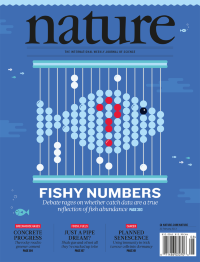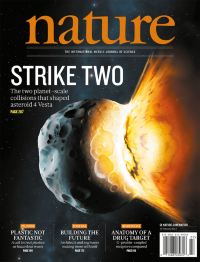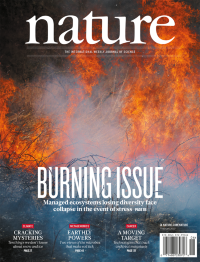Volume 494
-
No. 7438 28 February 2013
In the beginning was the word genome, and genomics. Now there are thousands of omes and omics out there, some of them firmly established as important bodies of knowledge and fields of study. Some are not, however, and have been variously condemned as unnecessary, trivial, frivolous, non-grammatical and worse. A News Feature in this issue surveys the omics scene with a view to spotting some that are here to stay. The puzzle on the cover airs a few of these words good, bad and ugly. Go.nature.com/7ihxut for printable puzzle. (Cover: Charles Wenz & Kelly Krause/ Nature)
-
No. 7437 21 February 2013
The fisheries industry around the world is in disarray. In some regions catches are stable and fishermen insist that all is well. Yet some researchers report fish numbers in dramatic decline and are calling for restrictions on fishing grounds. A central issue is the wisdom or otherwise of using estimates of the amount of fish hauled in by fishermen each year to assess the health of fisheries. In Comment this week we try to get to the facts. Daniel Pauly argues that catches, the only data available for many fisheries, are a crucial sign of the health of fish populations. Most fishermen today are catching fewer fish than their predecessors in the same waters. Catch data provide the information that researchers will need if they are to help reverse this trend. Ray Hilborn and Trevor Branch are not convinced. Many factors, not just abundance, determine the hauls of fishermen they say. Although important in terms of fisheries management, catch data alone cannot answer the question, how many fish are there in the sea? (Cover graphic: Denis Carrier).
-
No. 7436 14 February 2013
NASAs Dawn mission to the asteroid 4 Vesta revealed some unexpected surface features, including a huge crater, named Veneneia, underlying the even larger crater, Rheasilvia, that was formed about a billion years ago. The juxtaposition of these two impact basins provides an opportunity to develop an accurate model of Vestas topography. Martin Jutzi et al. report three-dimensional simulations of Vestas global evolution through two successive planet-scale collisions. Their model closely reproduces Vestas observed shape and provides a firm basis for the interpretation of the surface mineralogy and geology of Vesta, and by extension, other small Solar System bodies. On the cover, a representation of planet-scale collision forming the Rheasilvia impact basin at Vestas south pole (Illustration: Mark Garlick).
-
No. 7435 7 February 2013
Stretches of oak savanna in the Pacific Northwest of North America have been subject to fire-prevention measures since the mid-nineteenth century. The resulting grassland has lost plant species but achieves stable high-yield annual production rather like a high-yield agricultural system and remains resilient to invasive species and climate fluctuation. A long-term study in which selected grassland plots were periodically burned and allowed to recover now demonstrates the critical value of biodiversity when ecosystems experience disturbance. Grasslands were able to recover from burning only in areas that had a relatively high diversity of native plants. This work demonstrates how persistent human activity can homogenize both structure and function of an ecological system, while weakening the diversity-related mechanisms needed to compensate for sudden disturbance. There are many terrestrial systems today that have become homogenized by persistent human activity that may be similarly vulnerable to sudden environmental change that will be only evident after the collapse occurs. On the cover 'grass fire' (Dariush M/Shutterstock).




